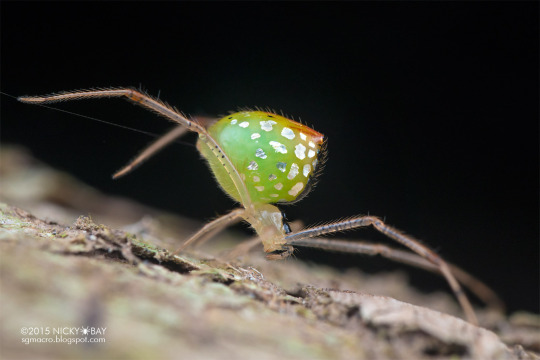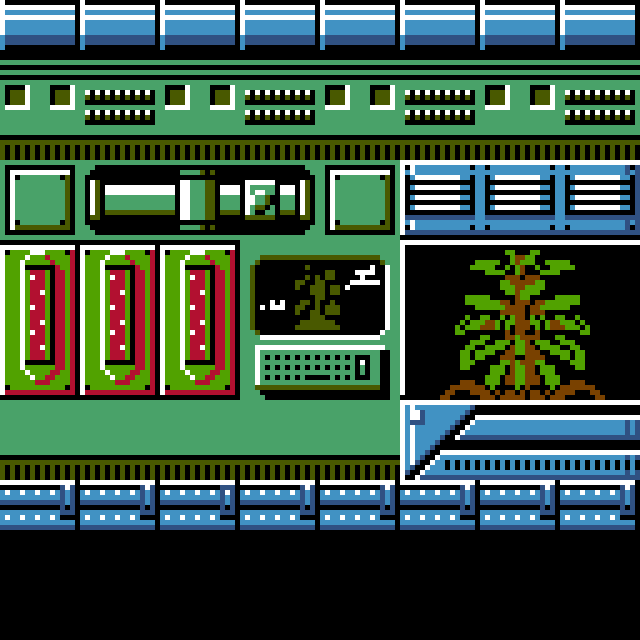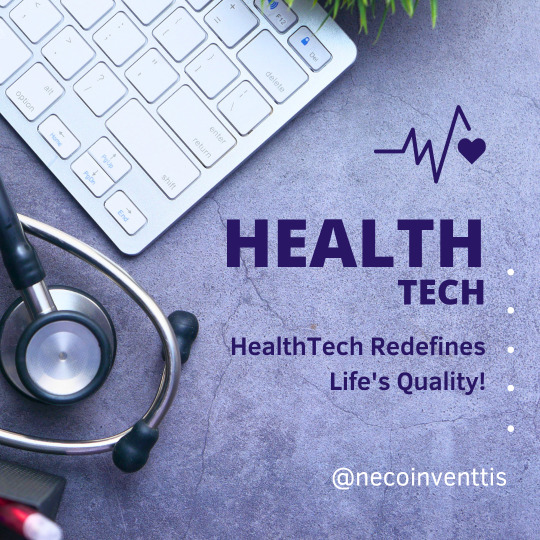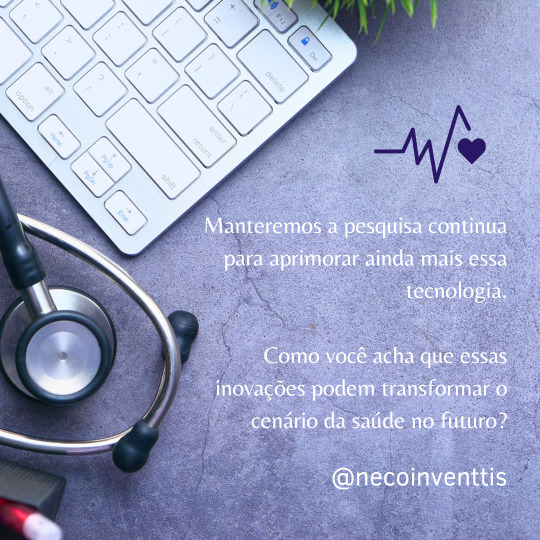#bioscience
Text




Thwaitesia argentiopunctata known as the sequined spider, mirror spider, or twin-peaked Thwaitesia, is a species of spider found in almost all states of Australia.
It is known to have a reflective abdomen that plays a crucial role in their camouflage to protect them from predators in the forest canopy.
The scales look like solid pieces of mirror glued to the spider's back, but they can actually change size depending on how threatened the spider feels. The reflective scales are composed of reflective guanine, which these and other spiders use to give themselves color.
[A-Z Animals: Sequined Spider]
#original post#fauna#Thwaitesia argentiopunctata#mirror spider#sequined spider#spider#insect#bio#biology#bioscience#bioblr#science#scienceblr#entomology#arachnids#invertebrates#bugs#bugblr#fun facts#nature#infopost
1K notes
·
View notes
Text

NES - Bio Lab
pixel_dailies : laboratory : restriction - 20px tiles or less : 11/16/23
#animation#pixel art#pixel artist#pixel art animation#looping animation#2d animation#digital animation#digital art#pixel dailies#artists on tumblr#laboratory#bioscience#tileset#nes color palette#scifiart
14 notes
·
View notes
Text


Finally got my bacteria to form biofilms! They are supposed to, it's their main virulence mechanism, but it took 3 biofilm assays to get here. You can't really see it in the top image after the washes and crystal violet stains but there was some visible biofilm in the wells. Looks like the O217 forms them a little better than the O219 but further experiments will reveal all.
146 notes
·
View notes
Text
Check out my recent video where I am sharing my Tips on Applying to Graduate School! 🎓
youtube
#black women#phdjourney#phd life#phdblr#graduate school#do some research#bioscience#application#application season#blackgirlmagic#phd student#phd#Youtube
3 notes
·
View notes
Text
Me going from migraine that makes me want to die, to applying to 2 different free university courses, playing 3 games at the same time, watching at the very least 3 shows and interacting with 11 different fandoms.
And all because of coffee, even tho it doesn't change the fact that I have no energy for any of those things
#i am tired#migraine is killing me#but coffee!#kuroshitsuji#gundam#tudor fashion#bioscience#one piece#pripara#aikatsu#dreamligh valley
3 notes
·
View notes
Text
Google research launched their YouTube channel: Explore video content that tackles state of the art research across Google like ML/AI, robotics, theory and algorithms, quantum computing, health, bioscience, and much more. Learn about the latest publications, research breakthroughs and the people behind them.
#google research#computer science#artificial intelligence#machine learning#quantum computing#bioscience
16 notes
·
View notes
Text
My idea is that cDNA libraries of the mRNA from humans of different ages, eg 1 year, 5 years, 10 years, 15 years, 22 years, 30 years, 40 years, 55 years, 70 years and 85 years (but practically it would be necessary to just take the samples that became available!) could be constructed or acquired. They could also be acquired from specific “aging critical” tissues/organs eg endothelium, cardiac, pulmonary, kidney, brain etc. The cDNA libraries could be compared by constructing microarrays (that is my dated knowledge but today it could probably be done computationally).
What would that give us? By the differences in the transcriptome between the different age cohorts it would show the difference between aged tissues and young tissues.
Of course, how these differences arose is AS a result of the epigenetic processes, but the differences themselves ARE the results of the epigenetic processes and (in some way which I am not able to imagine right now) may lead to approaches to discover more about the epigenetic processes themselves, which is your interest. Please forgive me if I am telling you things that are already second nature to you, but there is more to my proposal which is in fact quite simple really although very broad in scope and ambitious in outcome.
The differences mentioned above would be either the absence of specific mRNA in older tissues that is present in younger tissues, or vice versa, or quantitative differences in levels of mRNA.
That then gives a series of mRNA targets to investigate, both upstream, in terms of regulation of transcription such as transcription factors and silencing, and downstream in terms of identifying and characterising the protein product of the mRNA, its structure, binding sites, effects etc. That as you said before is quite a considerable body of work and would require many teams of researchers.
As far as intervention to promote health is concerned, discovering the epigenetic processes which cause the changes would be one pathway to treatments; other pathways could be pharmaceutical, perhaps based on transcription factors, and gene-therapy based approaches.
I think that the approach I have outlined is slightly different to that of the Yamanaka factors, which reset some cells to pluripotent stem cells, as my approach is intended to make differentiated cells youthful but still basically differentiated, as in the functioning young
adult.
I have heard of a researcher called Jaoa de Magalhaes who was said to be doing something like what I suggest (and he has now moved to Birmingham University in Britain) but I do not see mention of it on his website, he talks about long lived species, another interesting approach. An academic in Cambridge told me that she had heard of something like this that I propose being done in Singapore, but did not know the name of the researcher. So, although this approach is not truly novel, I believe it is still new ground.
#longevity#bioscience#biology#ageing#anti-ageing#molecular biology#research#scientific research#research proposal#DNA#mRNA
4 notes
·
View notes
Text

Empowering Change through Bio-Inspired Technological Evolution
Xenesis pioneers a new frontier of innovation, seamlessly blending Nature Intelligence with cutting-edge Artificial Intelligence to transcend conventional limitations. Our mission is to harness the transformative power of nature-infused technology, unlocking unparalleled opportunities for progress. Through biomimicry and advanced technological solutions, Xenesis redefines what's possible across industries. By drawing inspiration from the natural world, we strive to create sustainable solutions that address global challenges. With Xenesis, we embark on a journey towards a future where the harmony between nature and technology catalyzes unprecedented advancements, shaping a better world for generations to come.
To know more, please visit @ https://www.xenesis.bio/technology
Email: [email protected]
0 notes
Text
youtube
Dive deep into ETO Sterilization in Bio Science! Learn how this cutting-edge technique ensures the highest standards of sterilization for medical equipment. Stay informed, stay safe!
Watch our video at - https://www.youtube.com/watch?v=YLanatx5hCM
0 notes
Text
What is Biochemistry?
Biochemistry is the field of science that explores the chemical processes that occur in living organisms; in more basic terms, biochemistry is the science that studies how and through what processes life is possible.
As the name implies, it combines both biology and chemistry. Biochemists study everything from general chemistry to the function of proteins and how to create models 3D computer models of these proteins.
Although Biochemistry is a broad field, and there are many specializations, my hope for this blog is that I can make the basic concepts more understandable to everyone who wishes to learn more about them.
1 note
·
View note
Text





"Nautiluses are a living link to the ancient past.
They’ve been around over 480 million years, cruising deep ocean reefs even before the time of dinosaurs. These soft-bodied creatures live inside an intricately chambered shell.
A nautilus can only sense dark and light with its simple, pinhole-type eyes. But a nautilus can perceive water depth and current directions, as well as current speeds, to help it keep its body upright. A highly developed sense of smell helps a nautilus search for food and find mates."
Full article
- Monterey Bay Aquarium
#nautilus#fauna#monterey bay aquarium#original post#bio#biology#marine biology#bioscience#science#scienceblr#bioblr#molluscs#invertebrates#deep sea#deep sea creatures#fun facts#nature#infopost
2K notes
·
View notes
Text
Bioethanol Production from Food Crops
DM for Order sarasbooksonline.com
Contact : 099584 91228
#biofuels#biophysics#Bioscience#biology#HumanSurvival#protection#worldwide#biotech#science#technology#sarasbooksonline
0 notes
Text
🚀 What inspires you to invent? 🚀
Mergulhando nas inovações que moldarão o futuro, destaco as áreas de estudo essenciais para quem se inspira a inventar na interseção entre saúde e tecnologia. Se você deseja ser um agente de transformação nesse campo dinâmico, considere explorar:





1. Bioengenharia: A base da engenharia aplicada aos sistemas biológicos para impulsionar inovações médicas.
2. Biociências: Desbrave os mistérios da biologia, genética e microbiologia para criar soluções tecnológicas revolucionárias na saúde.
3. Engenharia Biomédica: Combine princípios de engenharia e medicina para criar dispositivos e tecnologias avançadas.
4. Ciência da Computação e Inteligência Artificial: Desenvolva algoritmos e softwares que potencializam a análise de dados e a tomada de decisões em saúde.
5. Nanotecnologia: Explore materiais e dispositivos em escala nanométrica para avanços significativos em diagnósticos e tratamentos.
6. Ética em Saúde e Tecnologia: Compreenda os desafios éticos e regulatórios para inovar de maneira responsável.
7. Gestão em Saúde: Adquira conhecimentos em administração e estratégia, fundamentais para implementar e otimizar soluções tecnológicas.
A combinação destas áreas é a chave para entender as necessidades do mercado e inspirar inovações que moldarão o amanhã. Qual destas áreas mais ressoa com a sua paixão por inventar? Compartilhe suas inspirações! 💬🌐
#innovation#invent#inventtis#inventions#technology#datascience#bioscience#bioengineering#healthtech#health it#WhatInspiresYouToInvent
0 notes
Text

🔬 Delve into the BillionaireBioscience Code: Human Body's Secret Unveiled!
A mere 5 years ago, scientists unearthed a "NEW" organ. Dive deep into the discovery that's revolutionizing our knowledge of the human body.
#BillionaireBioscience #BodyRevelation
0 notes
Text
Laying on my stomach, kicking my feet in the air and singing while writing in my lab notebook
#with a sparkly gel pen#lol#phdblr#phd#women in science#women in stem#gradblr#grad#studyblr#science#grad school#bioscience#biomedical engineering#biology#stem
2 notes
·
View notes
